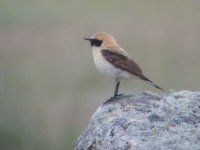This male wheatear was photographed in Extremadura, Spain, earlier this month.
Whilst hybirds between Pied and Black-eared Wheatears are well recorded, I personally know little, and can find little, about hybridisation with other wheatears, especially Northern Wheatear. Can anyone provide any pointers?
Or, does anyone else have an explaination we've missed for this bird's plumage? I know first-winter male melanoleuca can have a grey mantle, but a spring male presumed hispanica??
Cheers, BT
Whilst hybirds between Pied and Black-eared Wheatears are well recorded, I personally know little, and can find little, about hybridisation with other wheatears, especially Northern Wheatear. Can anyone provide any pointers?
Or, does anyone else have an explaination we've missed for this bird's plumage? I know first-winter male melanoleuca can have a grey mantle, but a spring male presumed hispanica??
Cheers, BT




